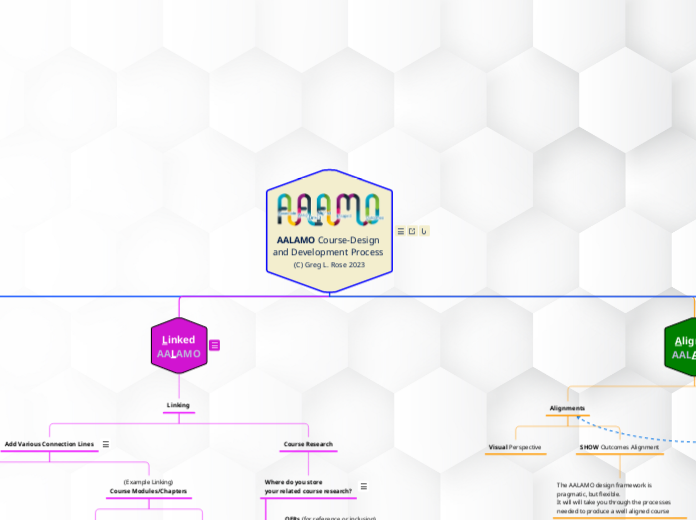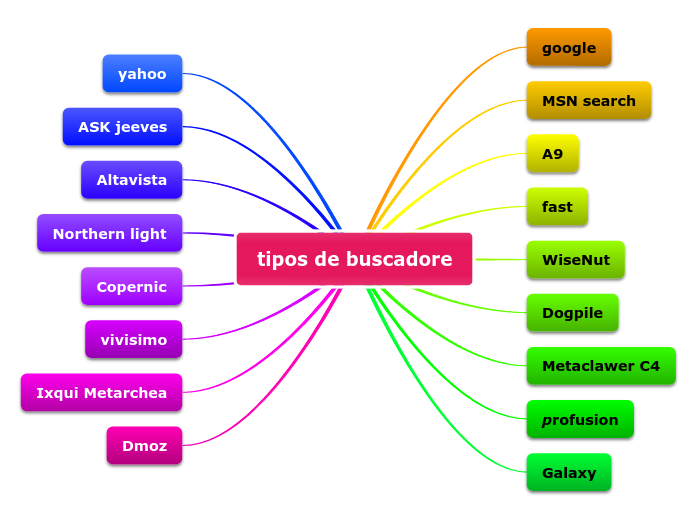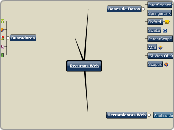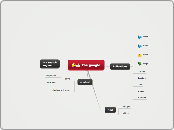AALAMO
Extras
Diagram Vendor
Extras
Customer support
Full Online Help Docs
FULL Diagram Searching!
Search Inside a Diagram
You can look for specific content within a mind map using the Search and Filter options.
With the Search option, all search results will be highlighted in yellow, leaving the rest of the content blurred.
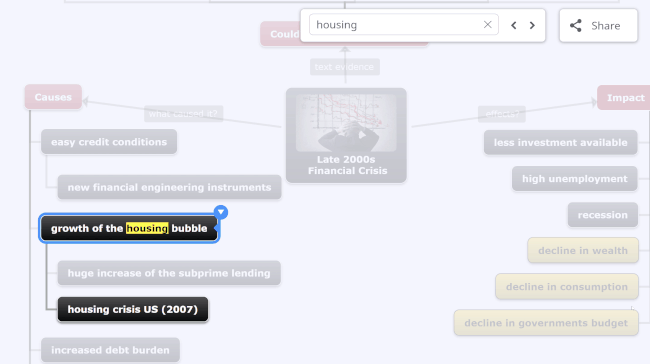
You can use wildcards to broaden your search by finding words that start or end with the same letters. You will have to use an asterisk (*) with a distinctive word stem to retrieve variations of the term with less typing. Use the asterisk at the end of the word stem to match all results that begin with that stem. If you use the asterisk at the beginning of the word, it will match all the results that contain or end with that stem.
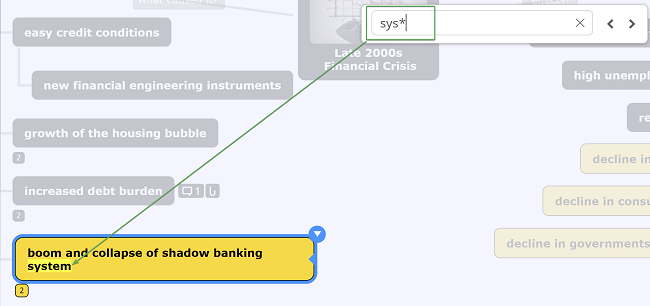
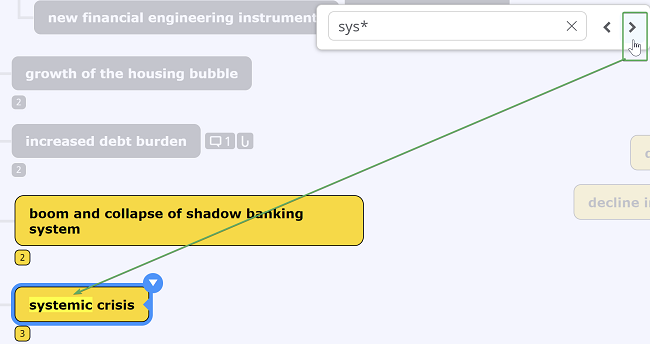
If you want to search for two words put together in the same phrase (in a topic, note, comment), then use the '+' (plus) sign in front of every word of the phrase (+high +unemployment) - the search will go through the mind map and look for all phrases that contain both 'high' and 'unemployment' and highlight them.
MORE...
Filter by Hashtag
Hashtag functionality helps you tag words in a topic and allows you to find specific content easier. You will be able to see accurate matches for your search or results that feature individual phrases in your search.
To add a hashtag type # and your word right after that, then press Enter. The hashtag will automatically appear in the filtering bar, where you will see how many times it is used in the diagram.
What AALAMO Does
Use the AALAMO process/architecture/diagram as a way to:
Save and Organize Course Materials,
Map Outcomes from top to bottom levels
Assignments
References & Research,
Hyperlinks,
Graphics
and Other NON-Course designs too!
AALAMO Course-Design and Development Process
(C) Greg L. Rose 2023
AALAMO Course-Design and Development Process
Questions? Contact Author by clicking the box/arrow link, or
Dr.Greg.Rose@outlook.com
Gregory L. Rose © June 2023 Ver: Final 1.1
The AALAMO Process - Purpose (The Why)
Reinvent and share an advanced digital visualization processes that empowers teachers, designers, and trainers to design and analyze better courses.
AALAMO - About (Assemble Assign Linked Aligned Mapped Outcomes) is a flexible course-design assembly and development/review process that is:
- Easy to learn and implement
- Non-linear editing (drag/drop or cut/paste)
- Fully customizable by faculty or designers
- Adaptable to any course delivery mode or LMS
- Iterative (save multiple versions, sequences, etc.)
- Online Display (with or w/o animations) and Print Options as desired
- Add color, notes, graphics, attachments and relationship links as desired
- Freemium or very low-cost options*
*The cloud-based software the AALAMO process runs on utilizes is very low-cost to implement (and a Freemium version is also available).
Disclaimer: Dr. Greg Rose is not affiliated with, and is not selling or profiting from this software or any related services. This AALAMO course-design process was developed and refined by myself over many years of Higher Education course development and management experience as well as training-course design/delivery practice. My original AALAMO process is being demonstrated here gratis as a professional courtesy to faculty and developers to promote best-practice course design at all levels. When utilizing this or a similar process your results will vary because only practice, collaboration and honest feedback will gradually move all of us from good to amazing! Greg Rose.
NOTE: I did not 'invent' eLearning course mapping, however I believe I have significantly augmented the course-design process by elaborating on and sharing the AALAMO process. Your feedback and contributions to this process are welcome and needed! Dr. Greg L. Rose
"Learning works best when beautifully designed."
MAESTRO website
Q1: Are you feeling STALE or STALLED with your Course Development efforts using those ancient 20th century tools?
Your Answer: (Yes - No - Maybe) ?
Q2: Is the course content and sequencing you imagined for your course "all over the map" and "not beautifully designed?" Do you feel you need a better, but creative, way to plan, collaborate on, build, then deliver your course or curriculum?
Your Answer: (Yes - No - Maybe) ?
Q3: Are the resources and research you collected for your course project, over time, well integrated into your course content, or are they perhaps forgotten or filed away 'somewhere unique' and got left out?
Your Answer: (Yes - No - Maybe) ?
IF YES to any of these questions: Remember
AALAMO: Assemble Assign Linked Aligned Mapped Outcomes Course-Design Process!
Outcomes
AALAMO
Outcomes in the AALAMO* Design/Assembly/Development Process:
*Assemble Assign Linked Aligned Mapped Outcomes
AALAMO is a visual course-design modeling process that captures and assembles the course you imagined and expands your designer tool set!
AALAMO Course-Design Assembly & Development Process
Copyright by Dr. Greg L. Rose 6/4/2023
Ver: Final 1.0
What goals or knowledge
will your audience attain?
Basic Course Design
'Start' Used by GR
My Course Idea Template (GLR)
(copy this topic, add to any diagram)
Basic Course Ideas Template GLR
STEP ONE:
Create/add the COURSE TOPIC off the TOP LEVEL
Course name, etc.
STEP TWO:
Copy the below into Notepad to create the MAIN TOPICS under a course:
Course Topics
Course Overview & Introduction
Course References to Include
Course Related Research
(2nd line above is a TAB character which creates a sub-topic)
STEP THREE:
Add or modify to the topics above to complete the basic course idea.
GLR
Editable AALAMO
DEMO Outcomes!
Course Related Research
LINK: Vimeo 1
"Stock Footage"
(Promo Reel)
Subtopic .... as many as needed
Subtopic 1
Course References to Include
(copied from 'Research')
Reference 2
Reference 1
Potential Course Topics
Chapter 2 Name
Chapter 1 Name
This chapter/module/unit will cover...
Outcomes or Goals for Learners
Outcome/Goal 3
Outcome/Goal 2
Outcome/Goal 1
Course Overview & Introduction
In this course...
Mapped
AALAMO
Mapped in the AALAMO* Design/Assembly/Development Process:
*Assemble Assign Linked Aligned Mapped Outcomes
AALAMO is a visual course-design modeling process that captures and assembles the course you imagined and expands your designer tool set!
AALAMO Course-Design Assembly & Development Process
Copyright by Dr. Greg L. Rose 6/4/2023
Ver: Final 1.0
Mapping your Course
Have you ever sailed off-course?
Map Design Phase 1
3 simple ways to start
building a course!
#How2Build
See the "3 simple ways to start an online course" from RISE 360 below ↓
Also note: the use of the "#" tag for additional searching and linking! You can 'tag' anything related to 'How2Build' with this tag!
Also, note the GRAPHIC pasted into this topic note below!
Also, notice the 'ICONS' that can go into a topic!
Excerpted from RISE 360:
------------------------------------- start excerpt -------
Start from the learning objectives.
Aligning these three components is a dynamic process, since a change in one necessarily affects the other two.

One way to approach course design is to start from the learning objectives, then move on to the other two components, and revisit the cycle iteratively as needed.
Articulating your learning objectives will help:
- YOU select and organize course content, and determine appropriate assessments and instructional strategies.
- STUDENTS direct their learning efforts appropriately and monitor their own progress.
More information on how clear learning objectives support students' learning.(pdf)
Remember AALAMO:
Organizing, building and sharing eLearning just got better!
Create and collaborate on any eLearning production with an AALAMO diagram that:
Assembles
Assigns
Linked
Aligned
Mapped
Outcomes
Dr. Greg L. Rose © December 1st, 2022
learning objectives
Instructional Activities
#How2Build
Assessments
IF Steven Covey (7 Habits author) were an Instructional Designer (ID), he would likely say to "Begin ... "
"Begin with the end in mind."
In other words, have set your goals and objectives? If not, get those defined first.
If you are new to course-design, follow the 3 simple steps to MAP your course below!
Aligned
AALAMO
Aligned
AALAMO Models add CREATIVE MAGIC!
How is Creative Magic made?
An AALAMO Visual Course-Design Model produces a clear, graphic model to help you see or refine your approach when designing your course or project.
Where does the MAGIC Happen?
Visual Alignments!
*Assemble Assign Linked Aligned Mapped Outcomes
AALAMO is a visual course-design modeling process that captures and assembles the course you imagined and expands your designer tool set!
Align Ideation with Collaboration
Invite co-workers or any member of your team to view, or help edit and organize your diagrams.
AALAMO Course-Design Assembly & Development Process
Copyright by Dr. Greg L. Rose 6/4/2023
Ver: Final 1.1
Align Ideation with Collaboration
Ideate in the ALAMO diagram is a way to think visually and iterate arrangements and try out new and unique combinations.
There is no rigid 'have to's' - let your creativity flow!
This is CLOUD-BASED, so Collaborate!
Share your diagrams in the following configurations:
Link sharing Settings (choose one):
OFF - Specific People
Specific people can access
ON - Public on the web
Anyone on the internet can find and View
ON - Anyone with the link can view
Anyone who has the link can View
+ OPTION: (on/off) Can copy
ON-Anyone with the link can edit (PRO version only)
Anyone who has the link can edit. No sign-up required.
Collaboration
Collaboration Skills: Examples
Indeed Editorial Team
"Collaboration skills are essential for nearly every role and industry. You can develop these skills in various ways to help you find increased success in your position. Understanding how to cooperate well with others can support workplace efficiency, aid your career advancement and help you and your team achieve better outcomes.
In this article, we discuss collaboration skills, the steps you can take to improve them and how you can highlight these skills in a job search, and we offer 20 examples of collaboration skills in the workplace.
Key takeaways:
- Collaboration skills can help you work well with others.
- Working as a team can increase productivity and develop healthy relationships between employees.
- Sharing ideas and brainstorming help develop unique solutions. "
Key Take Aways
Sharing ideas and brainstorming help develop unique solutions.
Working as a team can increase productivity and develop healthy relationships between employees.
Collaboration skills can help you work well with others.
Ways To Improve Them
Ideate
ideate
[ verb ahy-dee-eyt, ahy-dee-eyt; noun ahy-dee-eyt, ahy-dee-it ]
See synonyms for ideate on Thesaurus.com
verb (used with object), i·de·at·ed, i·de·at·ing.
to form an idea, thought, or image of.
verb (used without object), i·de·at·ed, i·de·at·ing.
to form ideas; think.
noun
ideatum.
WHY Ideate with an ALLAMO Flow Map?
HOW TO eDesign
by Tom Kuhlmann
(example Note and Link)
Excerpt from:
How I Stumbled Into E-Learning and Became a Successful E-Learning Designer
by Tom Kuhlmann
"E-learning can be a daunting task for anyone, but especially for those with no experience and also being a team of one.
But with some careful planning and execution, it can be a very successful endeavor. "
I agree with Tom!
However, The AALAMO course design and assembly process/architecture is my antidote to those daunting (as well as simple) course-design tasks!
Q: Do I use ALLAMO for every eLearning project?
A: No
Q: Do I use the AALAMO process frequently?
A: Yes!
I sincerely hope you will too!
Greg
→ Showcase & Deconstruction: Build Build long or shot examples and then discuss or deconstruct (solo or collaboratively).
See how and why topics were built so you can apply and re-apply new ideas to your own courses
I vote YES to this... anybody else?
→ Build Accessible Courses: Explore accessibility outside the scope of eLearning with NOTES and COMMENTS and then learn to use the tools and resources to build more accessible courses.
Constructing courses that meet accessibility requirements is very important!
→ Advanced Course Design: Extend your authoring capabilities with a visual focus on course flow, relationships and alignment to outcomes, and many-more advanced techniques.
→ Improving Course Design: Improve the quality and engagement of your eLearning or F2F courses with AALAMO architectures.
Alignments
SHOW Outcomes Alignment
The AALAMO design framework is pragmatic, but flexible.
It will will take you through the processes needed to produce a well aligned course
Visual Perspective
Linked
AALAMO
Linked in the AALAMO* Design/Assembly/Development Process
*Assemble Assign Linked Aligned Mapped Outcomes
AALAMO is a visual course-design modeling process that captures and assembles the course you imagined and expands your designer tool set!
AALAMO Course-Design Assembly & Development Process
Copyright by Dr. Greg L. Rose 6/4/2023
Ver: Final 1.0
Linking
Course Research
Where do you store
your related course research?
How about storing all your research (links, docs, pics, PDFs, etc.)... right in your AALAMO diagram!
Files (for reference or inclusion)
Graphics
As Embedded PNG (clear) in Topic
As File
Word Docs
Course Map Guide, 2019
(traditional grid style)
PDFs
Camtasia Shortcuts
VIDEOs (for reference or inclusion)
Insert your own Camera or Mic!
MP4s (will add to your storage limits)
or LINK: Vimeo 1
"Stock Footage"
(Promo Reel)
STREAM: Vimeo 1 "Stock Footage"
(Promo Reel)
OERs (for reference or inclusion)
Microeconomics
(example)
Proj. Mgmt (example)
Add Various Connection Lines
A variety of 'connection lines' in style and color can be drawn between any topics. The lines can be straight, curved, etc. (you choose the style, color and thickness).
Whenever you add a new topic in your concept map, you can instantly visually explain how it’s linked to any other topic(s) by labeling their connecting lines. As you add more topics, you may see new connections between your ideas you never saw before!
I suggest 'labeling' your connections between lesson topics and outcomes with the type of assessment (quiz, discussion, essay, etc.). EXAMPLE: label the connection line between your assignment with 'write essay' (or a short code of possible assessments) and 'connect' it to the outcome (this specifies how the outcome is satisfied, and how it is 'linked' to the outcome). GR
(Example Linking)
Course Modules/Chapters
(Example) Module 2
"Researching Topics"
Example Module 2 Content (kept in this TOPIC NOTE)...
Note: I would like to have a really enthusiastic greeting put into this (example) introductory module here and explaining why this module is so important!
(Headings, bold, etc. and be used and pasted back out):
---- begin ---- paste the below into LMS and PPT ↓ -----
Example Mod 2 Assignment:
Instructions: Write a Brief Essay
Example Module 2
Summary of Mod. 2
Includes Upload instructions
Leaner Assessment 2
(Example) Module 1
"Why write good well?"
Example Module 1 Content (kept in this "TOPIC NOTE").
AALAMO architect-designers could optionally keep in this attached topic note actual content or 'ideas' SPECIFIC to this topic (or any topic can optionally have a note attached).
----- start 'Content Example' below -----
Note: I would like to have a really enthusiastic greeting put into this (example) introductory module here and explaining why this module is so important!
(Headings, bold, etc. and be used and pasted back out):
---- begin ---- paste the below into LMS and/or PPT ↓ -----
Greetings Everyone!
I am very excited you are on this learning journey together with us today!
→ This course-journey-experience could be the most important class you have ever taken! ←
Why? Because designing courses for public, private, K-12 or university audiences has become more complicated and challenging with the introduction and rapid development of new technologies, presentation methods and analysis tools.
It is important (in fact, vitally important) you have:
- The latest design tools and methods at the ready!
- You can see both the micro and macro design views!
- Collaborate and ideate with your design colleagues!
- Assemble and disassemble full or partial prototypes!
- more to be continued later in this course - stay tuned!
In today's course, we will empower you with all the important and vital topics above, and much more! Journey on!
---- ↑ end copy ----
Example Mod 1 Assignment
Instructions: Read Chpts. 1+2
Example Module 1
Summary of Mod. 1
Includes Assessment instructions
Leaner Assessment
(Example Linking)
Course OUTCOMES (COs)
Outcome 2 (CO.2):
Demonstrate Writing Skills
Outcome 1 (CO.1):
Identify Writing Skills
Assign
AALAMO
ASSIGN in the AALAMO* Design/Assembly/Development Process
*Assemble Assign Linked Aligned Mapped Outcomes
AALAMO is a visual course-design modeling process that captures and assembles the course you imagined and expands your designer tool set!
AALAMO Course-Design Assembly & Development Process
Copyright by Dr. Greg L. Rose 6/4/2023
Ver: Final 1.0
Assigning
Any Topic
can be a task!
Creating a task is simple:
Click on any topic's menu (each topic has an array of options), next -
choose:
(1)Tools, then
(2) 'Set as task' .
The topic becomes a task and can be divided into smaller, assignable subtasks.
ASSIGNING the Task is even simpler!
Assign tasks and set deadlines
To assign a task, go to the context menu of a task topic (1) and click the option Add people (2). You will be redirected to the Share page where you type in the email address(s) of the collaborators you want to invite.
Monitor Progress
Set a priority for a task and monitor the completion and duration of it from the context menu of each task topic.
This is Incomplete (not checked), priority 3, 25% done, assigned to me (GR - Greg Rose)
Assemble
AALAMO
ASSEMBLE in the AALAMO* Design/Assembly/Development Process:
A Visual Course-Design Model that captures and assembles the course you imagined and expands your designer tool set!
✓ Flexible course curriculum content assembly and sequencing. Construct your course in the way you like to think and assemble and build the components it in your own style and sequence.
✓ A cloud-based holistic "systems mapping" approach.
✓ Easily create or change (drag/drop or cut/paste) the arrangement or re-arrangement of a course's content (non-linear editing) to improve and refine your course design.
✓ Adaptable to any course delivery method (F2F, Hybrid, Online, Video, etc.) and any LMS (BlackBoardTM, CanvasTM, DominKnowTM, ThinkificTM, etc.)
*Assemble Assign Linked Aligned Mapped Outcomes
AALAMO is a visual course-design modeling process that captures and assembles the course you imagined and expands your designer tool set!
AALAMO Course-Design Assembly & Development Process
Copyright by Dr. Greg L. Rose 6/4/2023
Ver: Final 1.0
Assemble a 'Concept Map' not a 'Mind Map'
What's the difference?
In contrast with the rigid structure of the mind map, the concept map maintains a flexible layout. It allows you to move your topics anywhere on the map canvas by dragging them and organize your map as you see best.
Whenever you add a new topic in your concept map, you can instantly explain how it’s linked to the previous one by labeling their connecting lines. As you add more topics, you may even see new connections between your ideas.
From https://www.slideserve.com/lorene/alternative-assessment-powerpoint-ppt-presentation
From:
Alternative Assessment
by Dr. M SOZBILIR, sozbilir@atauni.edu.tr
Slide 18:
Alternative Assessment Methods/Tools
•Portfolios /e-portfolios
•Concept maps/mind maps
•Rubrics
•Check lists
Slide 22:
Concept Map vs Mind Map
A concept map is a diagram showing the relationships among concepts.
It is a graphical tool for organizing and representing knowledge.
Concepts, usually represented as boxes or circles, are connected with labeled arrows in a downward-branching hierarchical structure.
The relationship between concepts can be articulated in linking phrases.
Examples "gives rise to", "results in", "is required by," or "contributes to" etc.
A mind map is a diagram used to visually outline information.
A mind map is often created around a single word or text, placed in the center, to which associated ideas, words and concepts are added.
Major categories radiate from a central node, and lesser categories are sub-branches of larger branches.
Learn More: Constructing your First Concept Map
by: Alberto J. Cañas & Joseph D. Novak
https://cmap.ihmc.us/docs/constructingaconceptmap.php
"Finally, the Cmap should be revised, concepts re-positioned in ways that lend to clarity and better over-all structure, and a “final” map prepared. When computer software is used, one can go back, change the size and font style, and add colors to “dress up” the concept map.
Thus, we see that concept maps are not only a powerful tool for capturing, representing, and archiving knowledge of individuals, but also a powerful tool to encourage meaningful learning and to create new knowledge."
Take-on Assignments
"Learn
everything about..."
GLR:
Back in 2019, my supervisor said,
"Greg, one of your assignments is to learn everything about our new integrated adult continuing-ed course-delivery/LMS - marketing platform."
That is a big assignment, especially as I had never worked in that particular LMS ecosystem before!
So, I FIRST:
went to the LMS vendor's website (www.thinkific.com), copied a multitude of their 'bullet point' type descriptions on:
- product features,
- site administration features,
- teaching features,
- marketing features,
- Etc.
SECOND:
I build a concept map (using the software I use for AALAMO Course Development) and build a 'reference map' that I could add links to, graphics to, descriptions, and my own notes and assignments to.
RESULT:
Using this technique, in a relatively short time, I became their "LMS expert" on that platform and was able to assist them to build out their courses and many enhancements to their teaching and learning experience, largely in part due to my ability to map, reference, search and find most of what I needed to know about this LMS in one place.
A Competitor
or Employer Map?
"An LMS
ecosystem"
"Take this massive
medical-topic website,
and turn it into
an online course."
Gather Research
Gathering Research:
Gather some, or all of your related research in your AALAMO diagram.
Save/Integrate/Edit Your Course Research Efforts - never lose or misplace research elements again!
The AALAMO process and allows for the editing and direct inclusion of both formal and informal references, written content/narrations, notes, documents, PDFs, graphics, and hyperlink resources directly into the developing or final course AALAMO design document.
GLR
Collect Objectives
(outcomes)
Gather and List your anticipated course (or design) Objectives/Goals/Outcomes.
If they are per-determined, say by the curriculum committee or SME or yourself, formally add them in the suggested AALAMO format in your process diagram.
GLR
Build an Outline
Outline the thinking process for a particular course (or communication problem) by considering several design factors and work with them in an online concept map.
Note - this can be done in any order... the AALAMO process allows to assemble your key elements in any order and arrange/align later.
GLR
